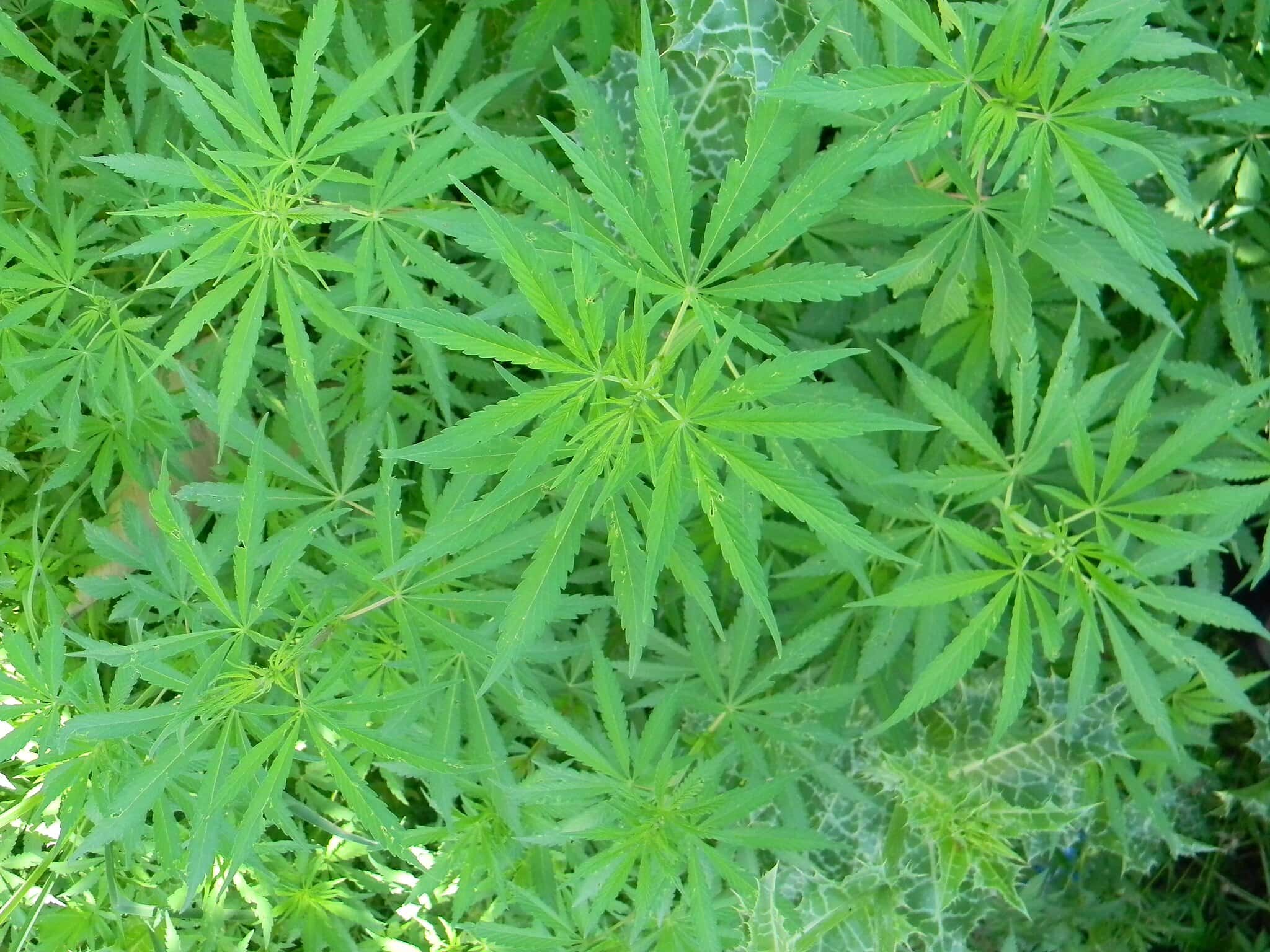Nature often plays tricks on our eyes. It is not uncommon to stumble upon a flower or plant that bears an uncanny resemblance to the much-debated and renowned cannabis plant. While marijuana has gained popularity for its unique leaf shape and distinct aroma, it is important to remember that the plant world is teeming with lookalikes. Discover fifteen fascinating flowers that look like weed but are not and have entirely unique characteristics and uses.
How to Recognize a Cannabis Plant
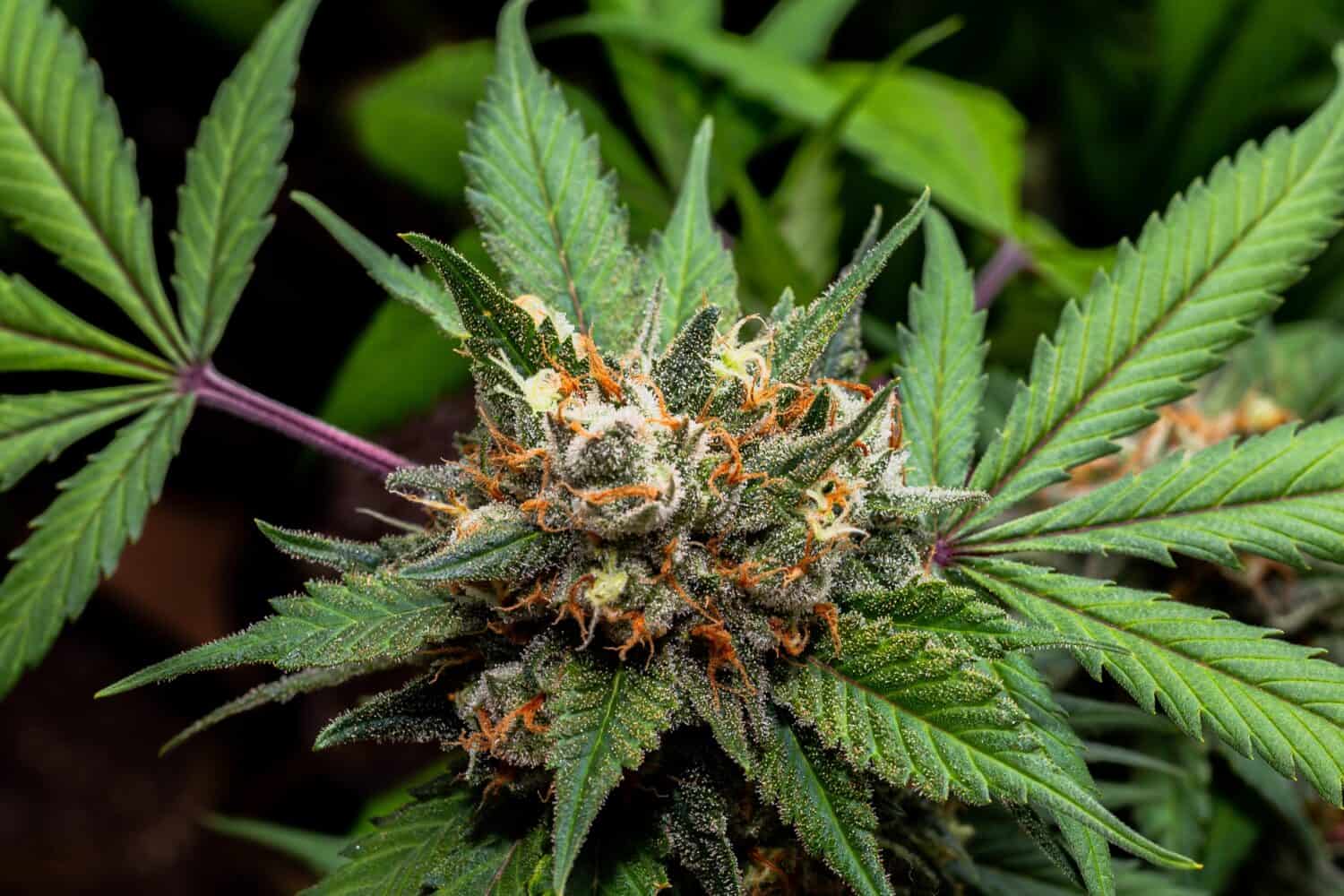
Cannabis use is 2,500 years old.
©Kaylin Colette/Shutterstock.com
Before we dive into the world of look-alike flowers, it is crucial to understand what a genuine cannabis plant looks like. While many plants resemble marijuana, knowing the distinguishing features of cannabis can help you differentiate between the real deal and imposters.
- Leaf structure: The plant’s most iconic feature, its leaves comprise serrated, palmate leaflets with a distinctive pattern. These plants have five to nine leaflets per leaf, radiating outward from a central stem. The leaves often have a deep green color, but the color varies depending on the strain.
- Stalk and branches: Cannabis plants have a sturdy, woody stem that grows quite tall, especially in outdoor conditions. They develop a central stalk with branches extending outwards, creating a bushy appearance. Additionally, the branches are often covered with leaves and, later, buds.
- Buds and flowers: The most sought-after part of the cannabis plant is its flowers, commonly referred to as “buds.” Tightly packed clusters of resinous and trichome-covered flowers range in color from light green to deep purple, depending on the strain. The scent of mature cannabis buds is also quite distinctive, characterized by a pungent, skunky aroma.
- Trichomes: Cannabis plants develop tiny, crystalline structures called trichomes on their leaves and buds. These trichomes contain cannabinoids like THC and CBD and handle the psychoactive and therapeutic effects of the plant. The presence of trichomes is a clear sign that you are dealing with a cannabis plant.

15 Flowers That Look Like Weed But Are Not
1. Basil (Ocimum basilicum)
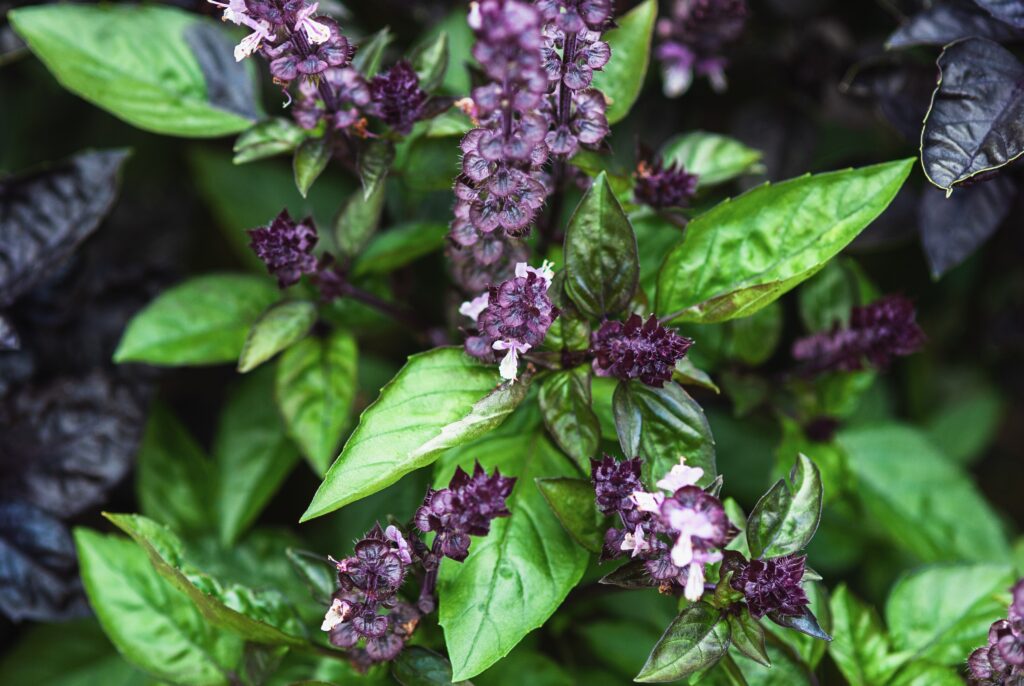
Cinnamon basil’s unique purple blooms are often mistaken for the marijuana plant’s trichomes.
©Nadya So/Shutterstock.com
Basil is a fragrant herb celebrated for its culinary uses and aromatic leaves. While its serrated green leaves might remind you of marijuana at a glance, basil’s distinct scent and culinary importance set it apart.
This herb is a staple in various cuisines, particularly Italian and Southeast Asian dishes, where its fresh, sweet aroma and peppery flavor enhance dishes like pasta, salads, and curries. Basil’s leaves vary in size and shape, with some varieties exhibiting a more pronounced resemblance to cannabis than others.
Despite the visual similarity, you will not find any mind-altering effects associated with basil. Instead, it offers a delightful culinary experience and potential health benefits, including anti-inflammatory properties. So, when you encounter basil in your garden or at the market, rest assured it is a delicious herb ready to elevate your culinary creations.
Common varieties with similar appearances to weed include:
- Cinnamon Basil (Ocimum basilicum ‘Cinnamon’): Cinnamon basil has narrower leaves than some other varieties. However, they still resemble cannabis leaves to some extent because of their serrated edges and green color.
- Genovese Basil (Ocimum basilicum ‘Genovese’): Genovese basil is a classic Italian basil variety with broad, bright green leaves. Although its leaves are not prominently serrated like some other varieties, the overall shape and color are reminiscent of cannabis leaves.
- Lettuce Leaf Basil (Ocimum basilicum ‘Lettuce Leaf’): This basil variety has large, broad leaves that appear similar to cannabis leaves, especially as they grow larger. It is often used for making pesto because of its abundant foliage.
- Purple Basil (Ocimum basilicum ‘Purpurascens’): Purple basil has purple-tinged leaves. While the coloration is distinct from cannabis, the leaf shape is similar, causing confusion.
- Thai Basil (Ocimum basilicum var. thyrsiflora): Thai basil has narrow, pointed leaves with a slightly purple tint on the stems. It is a staple in Thai cuisine and can resemble marijuana leaves, especially when they grow larger.
2. Cassava (Manihot esculenta)

Cassava is the third largest carbohydrate source on earth.
©GOLF2614/Shutterstock.com
A vital staple crop, cassava, or yuka, is native to South America. The woody shrub’s crop foliage resembles weed. Cassava is a tropical root crop that thrives in warm climates. Its edible, starchy, tuberous roots are a primary source of carbohydrates in many regions.
The cassava plant typically features large, palmate leaves with five to seven lobes. These leaves bear a superficial resemblance to cannabis leaves because of their shape and size, but they lack the serrated edges and distinct leaflets associated with marijuana plants.
The primary importance of cassava lies in its nutritional value and versatility in cooking. Its roots form cassava flour, tapioca pearls, and even cassava-based beverages. It is a valuable source of dietary energy and is consumed in both traditional and modern dishes, making it a crucial food source for many communities worldwide.
3. Chaste Tree (Vitex agnus-castus)
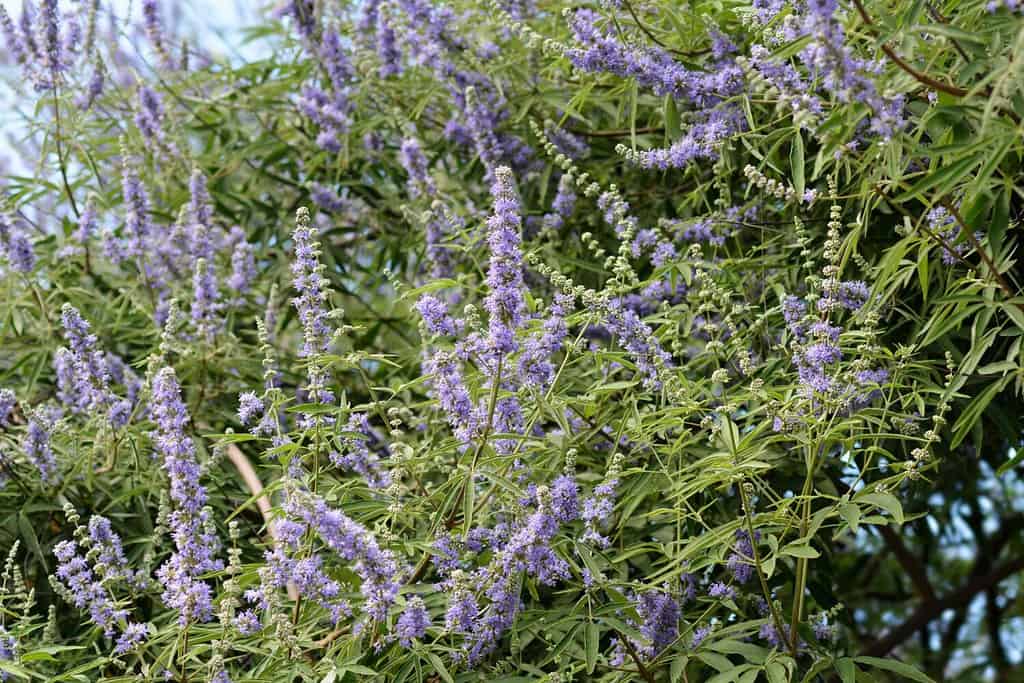
The chaste tree’s leaves feature the same unique star pattern as the cannabis plant without its trademark toothed edges.
©Nahhana/Shutterstock.com
Chasteberry, or the chaste tree, is an ornamental shrub that is often mistaken for the cannabis plant, thanks to its unique appearance. These trees are native to the Mediterranean region and boast aromatic, palmate leaves that resemble cannabis leaves.
Both the chaste tree and cannabis plants have palmate leaves, with leaflets radiating from a central point. However, the leaflets of chaste trees are larger and more elongated compared to cannabis. Chaste tree leaflets are deeply toothed, while cannabis leaves have finer serrations.
The arrangement of leaves on the plants is also different. Chaste tree leaves grow in pairs or clusters along the stem, whereas cannabis leaves are usually alternate, growing singly on opposite sides of the stem. Chaste tree leaves are also aromatic when crushed and have a distinctive fragrance. In contrast, marijuana leaves have a pungent, skunky odor when crushed, which differs greatly from the pleasant aroma of chaste tree leaves.
Additionally, chaste tree leaves are green but vary depending on the variety, whereas marijuana leaves range from bright green to deep purple, depending on the strain. Chaste tree leaves also attach directly to the stem, while cannabis leaves have a short leafy stem that attaches to the main stem.
4. Coral Plant (Jatropha multifida)
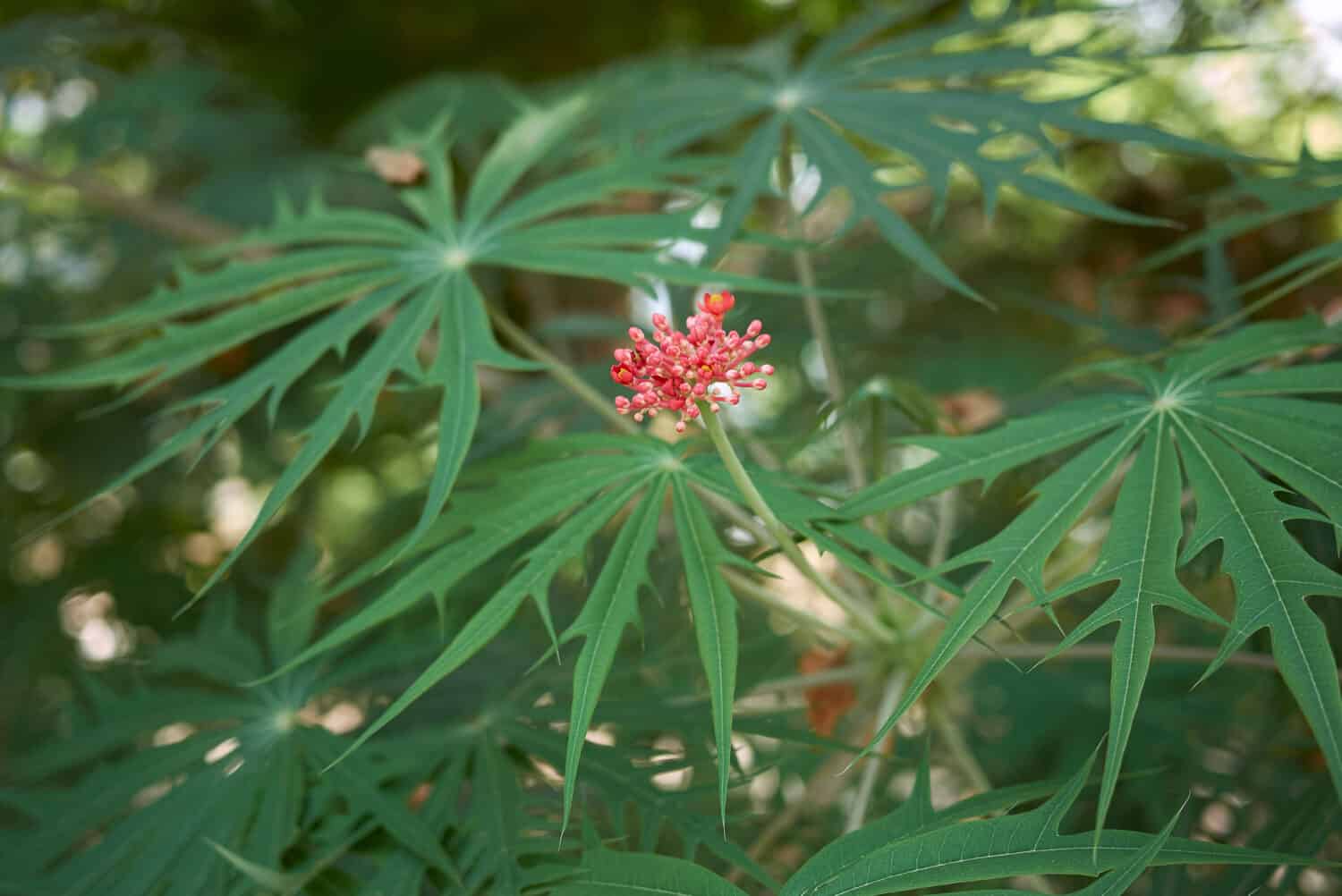
This ornamental garden plant has smooth-edged leaves that otherwise resemble marijuana plant leaves.
©simona pavan/Shutterstock.com
The coral plant is a remarkable tropical flowering shrub that can sometimes be mistakenly associated with marijuana because of its distinctive leaf structure. Native to Central America, the coral plant is a striking ornamental addition to gardens and landscapes, known for its lush foliage and bright red or coral flowers.
At first glance, the deeply lobed leaves of the coral plant bear a superficial resemblance to cannabis, and both exhibit palmate structures. However, marijuana leaves have serrated edges, while the coral plant’s unique leaves are smooth and deeply lobed.
Coral plant leaflets attach directly to the main stem. In contrast, marijuana leaflets often have a short leaf stem that attaches to the main stem. The coral plant’s leaves are also smooth and have a glossy appearance. Marijuana leaves vary in texture, but they are often slightly rough to the touch.
The coral plant adds an exotic and tropical flair to gardens. They also produce clusters of coral flowers, which are rich in nectar, attracting pollinators like butterflies and bees. Furthermore, the coral plant’s leaves and flowers make it a standout in landscaping, showcasing the intriguing variety of shapes and colors that nature offers.
5. Hemp Agrimony (Eupatorium cannabinum)

Hemp agrimony’s palmate leaves resemble cannabis before maturity.
©MacBen/Shutterstock.com
Find this ecologically significant perennial in wetlands. Hemp agrimony shares a scientific name resembling the cannabis plant, producing opposite, lance-shaped, and serrated leaves. One of the notable features of hemp agrimony is its clustered inflorescences of small, pink-to-purplish flowers. These dense, fluffy flower heads create a visual spectacle and attract various pollinators, making specimens valuable plants in wildlife habitats.
Hemp Agrimony leaves are typically lance-shaped and serrated along the edges. They have a simpler leaf structure compared to marijuana’s compound leaves. However, both plants produce serrated foliage arranged opposite each other. Hemp agrimony leaves are larger and broader compared to marijuana leaves, which are often smaller and more elongated.
6. Hops (Humulus lupulus)

The hops plant’s leaves are fuzzy, unlike the smooth leaves of the cannabis plant.
©Vaclav Mach/Shutterstock.com
Famous for a different type of feel-good feeling, hops are perennial climbing plants celebrated for their unique cones, which are a fundamental ingredient in brewing beer. Hops leaves feature lobed and serrated edges. They have a palmate structure, with five to seven lobes radiating from a central point, giving them a distinctive look.
Marijuana leaves also have a palmate structure with serrated edges and five to seven leaflets radiating from a central stem. Both hops and cannabis leaves grow opposite each other. However, hops leaves are larger and broader than marijuana leaves.
Additionally, hops leaves are soft and have a fuzzy texture, while marijuana leaves are thicker. Hops provide bitterness, flavor, and aroma to beer, acting as a natural preservative. They are vigorous climbers and grow well on trellises or support structures.
7. Japanese Maple (Acer palmatum)
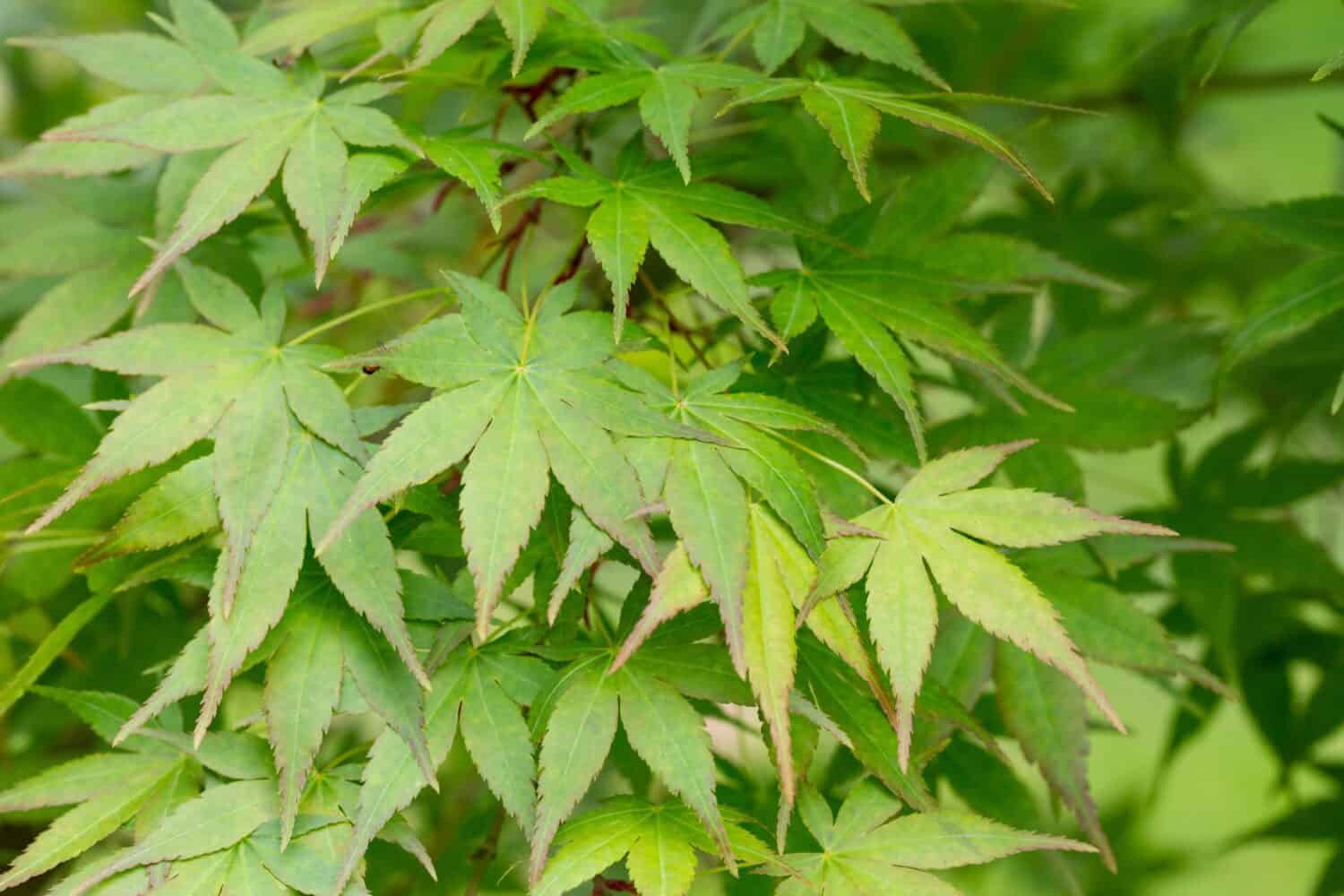
Japanese maple’s compound palmate leaves resemble larger cannabis leaves.
©AnnaNel/Shutterstock.com
This captivating ornamental tree’s foliage resembles marijuana leaves. Japanese Maple is a small to medium tree with an elegant form that makes it a great focal point in any landscape. It has cultural significance in Japan, where the Japanese consider it a symbol of grace and beauty.
Japanese Maple leaves are typically palmately lobed, meaning they have multiple lobes radiating from a central point, like the fingers of a hand. These lobes are deeply incised and often have serrated edges. In contrast, marijuana leaves are serrated along the edges and typically compound, with leaflets arranged along a central stalk.
Additionally, Japanese maple leaves grow alternately along its branches, while marijuana leaves grow opposite each other. Japanese maple leaves also tend to be relatively thin and papery, with a delicate texture. However, marijuana leaves vary in texture but are often thicker and have a more robust feel.
Japanese Maple leaves vary in size depending on the variety but are typically larger and more prominent than marijuana leaves, which are often smaller and less conspicuous. They also come in a wide range of colors, including various shades of green, red, purple, and variegated combinations. Marijuana leaves are typically green, although the specific shade varies depending on the strain.
8. Kenaf (Hibiscus cannabinus)

Kenaf’s leaves closely resemble weed before the plant blooms.
©AnithamRaju Yaragorla/Shutterstock.com
Don’t let the scientific name fool you. Kenaf is a versatile and fast-growing annual plant that bears a resemblance to marijuana thanks to its similar-sounding name, and some shared visual characteristics. It is a member of the Hibiscus genus. Kenaf produces tall, upright stems, palmate leaves, and distinctive yellow flowers with deep red centers.
Its leaves and general growth structure resemble cannabis, which leads to confusion. However, once mature, it is easy to tell these two plants apart. Despite their visual similarities, kenaf produces fibers and seeds, which have various industrial applications. Manufacturers use the plant’s fibers to make products like paper, textiles, and cordage, while the seeds yield oil rich in essential fatty acids.
9. Mugwort (Artemisia vulgaris)
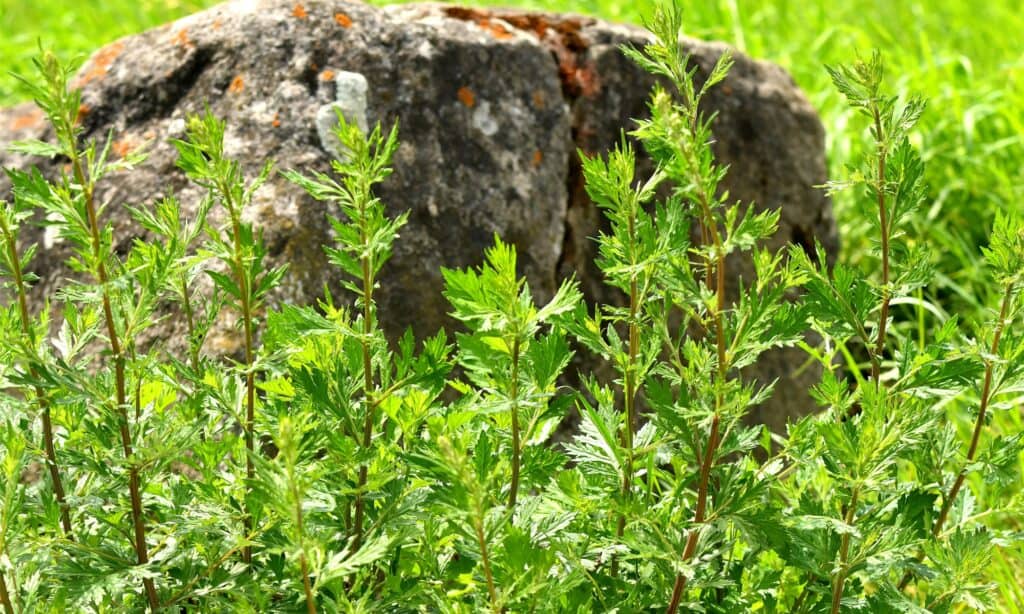
Unlike weed leaves, mugwort’s leaves have silvery undersides.
©iStock.com/HansJoachim
Mugwort only sounds like it is from the Wizarding World of Harry Potter. It is a versatile and aromatic herbaceous plant that has a long history of traditional uses. Its distinctive appearance and properties occasionally lead to comparisons with marijuana.
Mugwort leaves are one of its key features. They are deeply lobed and finely divided, with a silver-green coloration on the undersides, giving them a somewhat feathery appearance. They have a narrow and elongated shape. On the other hand, marijuana leaves are typically compound with serrated edges and a distinct, palmately lobed structure. Marijuana leaves also have five to seven leaflets radiating from a central stem.
Mugwort leaves grow alternately, while cannabis leaves grow opposite each other. Additionally, both plants produce an aroma. Mugwort has a strong, pleasant aroma when crushed and is described as slightly sweet and herbal. However, marijuana has a pungent odor when crushed.
Mugwort also holds cultural significance in some regions. In certain traditions, it is associated with protection, divination, and spiritual practices. Mugwort’s unique aroma and historical uses have contributed to its importance in various cultural and medicinal contexts.
10. Okra (Abelmoschus esculentus)
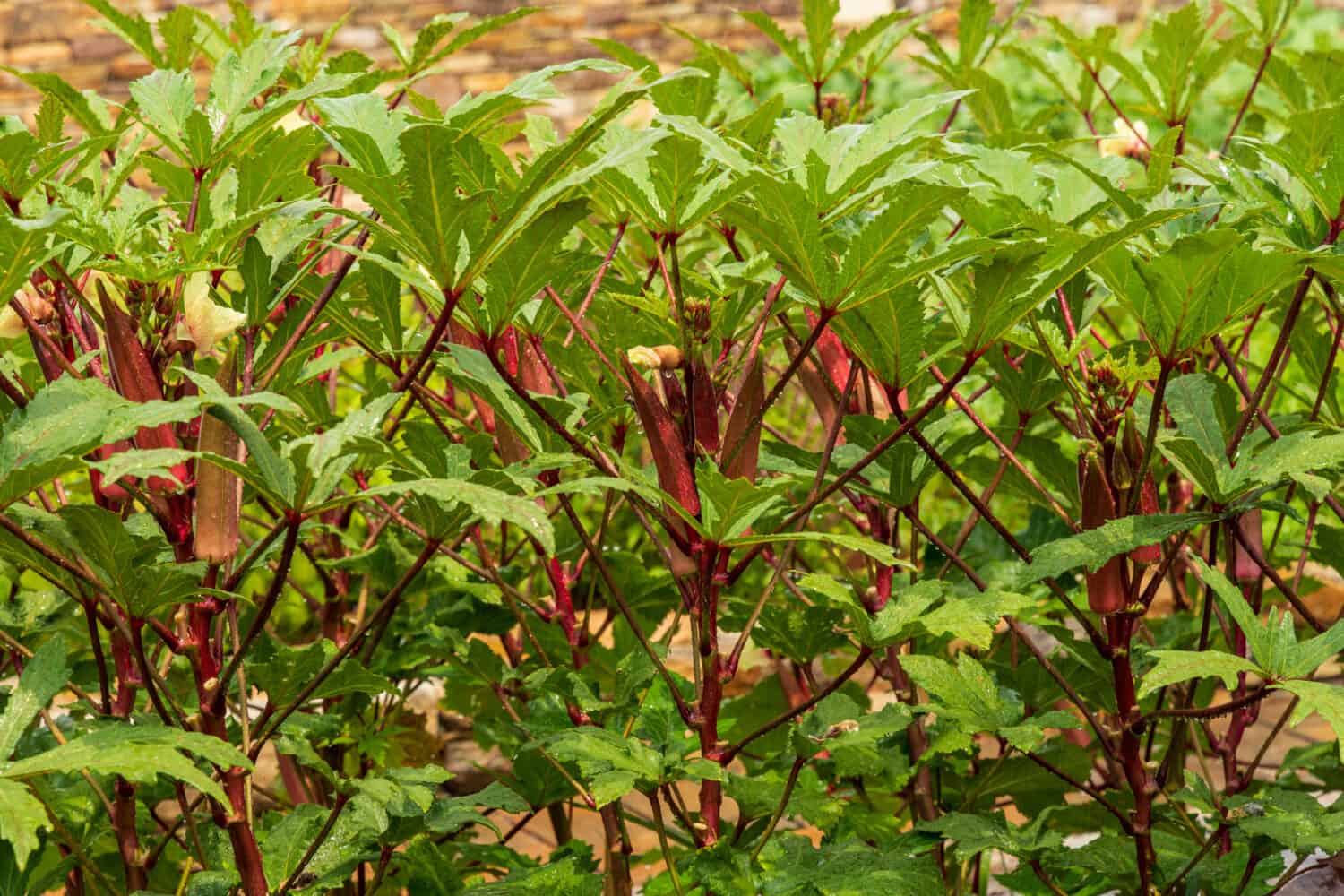
Okra and cannabis both have broad, palmate leaves growing from tall plant structures.
©Liz Albro Photography/Shutterstock.com
Homeowners and farmers cultivate this versatile and delicious vegetable in warm climates around the world. Okra’s distinctive appearance has led to occasional comparisons with marijuana plants. It is a member of the Mallow family and valued for its tender, elongated pods, which are a staple ingredient in various culinary traditions, particularly in Southern and Creole cooking.
Okra’s pods are sometimes called “lady fingers” because of their slender, finger-like shape. Specimens reach up to 6 feet, with large, palmate leaves that differ significantly from the serrated leaves of cannabis plants.
Unlike marijuana, which bears psychoactive compounds, okra is an edible fruit with a mucilaginous texture. It is a popular thickening agent in gumbo and other dishes. Okra’s nutritional profile is a rich source of vitamins, minerals, and dietary fiber. While the leaves of okra share similarities with marijuana plants, the two are distinctly separate in terms of botanical classification, usage, and effects.
11. Southern Marigold (Tagetes minuta)

Seedling southern marigolds resemble cannabis plants.
©Ava Peattie/Shutterstock.com
The southern marigold is a captivating and versatile flowering plant native to South America. It produces finely divided, fern-like leaves, which appear similar to marijuana leaves at first glance. Southern marigold grows as a tall, bushy plant with delicate green foliage.
Both southern marigolds and some marijuana plants have deeply divided or dissected leaves. The leaves of both plants have multiple lobes or segments, giving them a feathery or fern-like appearance. However, southern marigold’s leaves grow alternately along its stem, meaning one leaf attaches at each node, alternating sides. In contrast, marijuana leaves grow opposite each other, with pairs of leaves growing directly across from each other on the stem.
Furthermore, southern marigold’s leaves are smoother and have a glossy appearance, and marijuana’s leaves vary in texture. While both plants have dissected leaves, the serration or fine tooth-like edges of southern marigold leaves differ from the serrated edges of marijuana leaves, which are typically more pronounced.
Southern marigold leaves also have a pungent, citrus-like aroma when crushed, which is distinctive and differs significantly from the scent of marijuana leaves. Its leaves are typically bright green, while marijuana leaves vary in color depending on the strain.
12. Spider Flower (Cleome hassleriana)
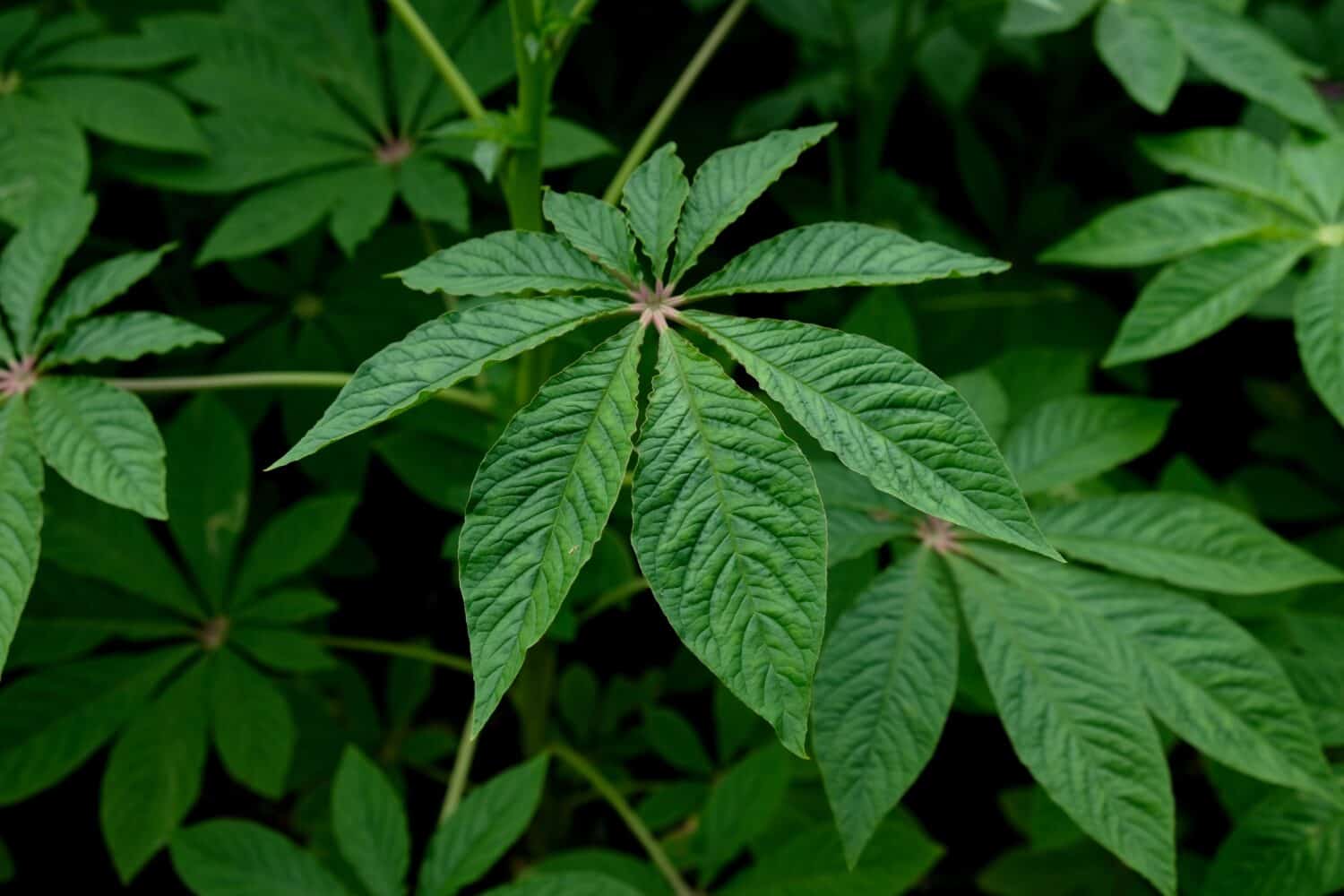
The spider flower’s foliage closely resembles weed.
©kaiwut niponkaew/Shutterstock.com
The spider flower is a charming annual plant that often catches the eye because of its unique appearance. Some individuals might mistake its distinctive foliage for marijuana. Spider flowers produce elegant, palmate leaves that appear similar to certain cannabis leaflets, especially to those less familiar with weed identification.
These plants typically grow up to 5 feet, with clusters of delicate, spider-like flowers that come in a range of colors, including pink, purple, and white. Spider flowers are primarily ornamental, and gardeners appreciate their ability to attract pollinators like bees and butterflies while adding a touch of whimsy to landscapes.
Spider flowers and cannabis plants produce serrated leaves that are often mistaken for each other while the spider flower is not in bloom. When spider flower specimens mature, they produce distinct flowers that set them apart from marijuana.
13. Sunn Hemp (Crotalaria juncea)
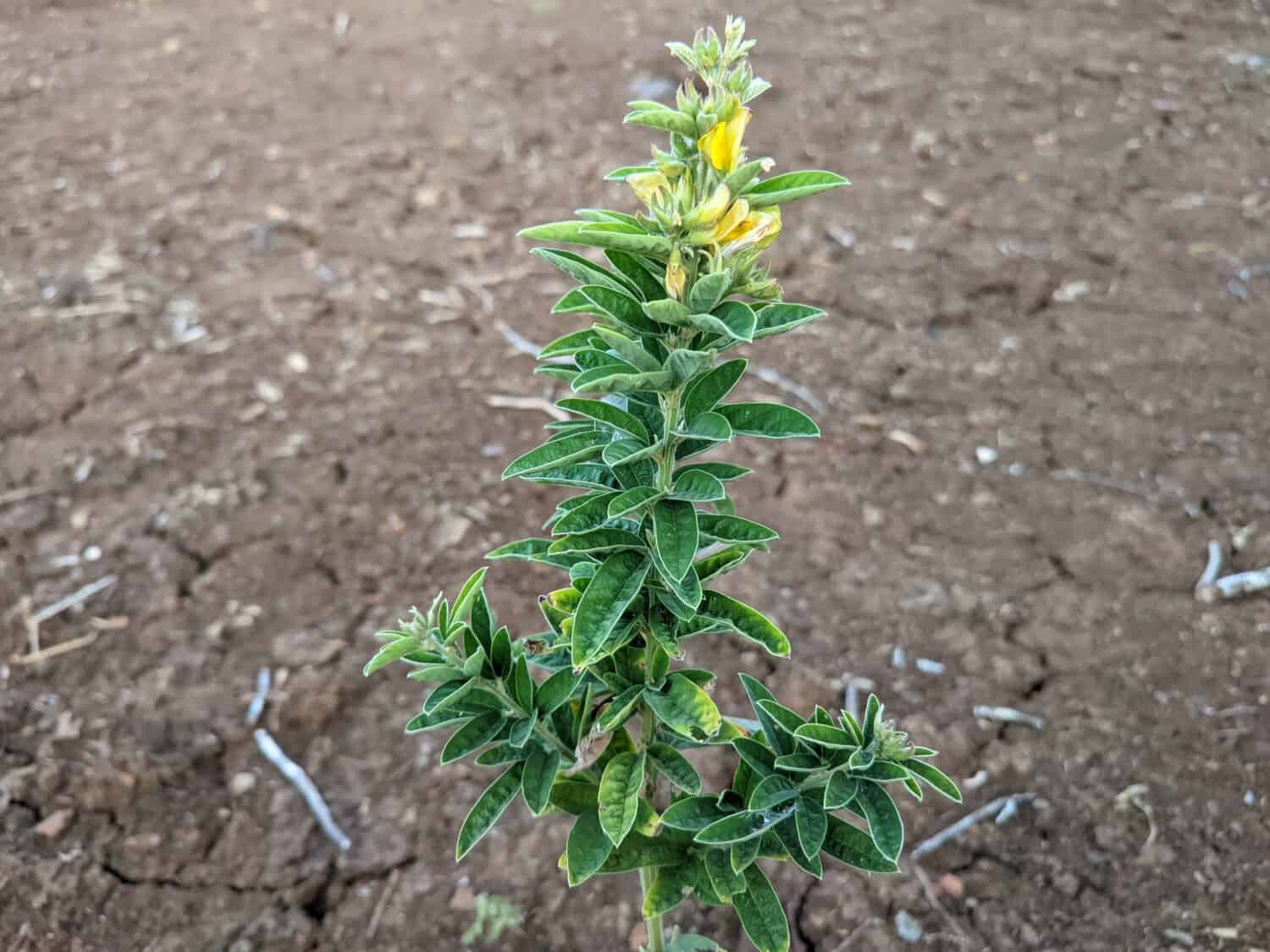
Sunn hemp resembles cannabis sativa.
©Wong Gunkid/Shutterstock.com
Sunn hemp, also known simply as “sun hemp, belongs to the pea family, Fabaceae. It is an annual warm-season legume that is primarily grown as a cover crop and soil improvement crop rather than for consumption. It also bears a resemblance to marijuana because of shared characteristics in leaf shape and growth habits.
Sunn hemp grows rapidly and enriches soil, making it a valuable plant for agriculture and sustainability efforts. It is a tall, fast-growing plant that can reach up to 10 feet. It has a bushy growth habit with multiple stems and compound leaves composed of small leaflets, similar to the cannabis plant. Sunn hemp also produces bright yellow flowers that resemble those of other legumes and eventually form seed pods.
Unlike marijuana, sunn hemp has no psychoactive properties. Additionally, it is a valuable tool in sustainable agriculture practices, contributing to soil health and crop productivity while also serving as a natural and environmentally friendly means of weed control and soil enrichment.
14. Sweet Woodruff (Galium odoratum)

Before blooming, sweet woodruff’s star-shaped leaves resemble weed.
©ESB Basic/Shutterstock.com
Sweet woodruff is a charming and fragrant perennial herb that is cherished for its delicate beauty and distinctive aroma. This plant is less likely to be confused with marijuana. However, its finger-shaped leaves have similar characteristics to marijuana’s palmate foliage.
Sweet woodruff produces lance-shaped leaves that are whorled in groups of six to eight around its stem and are typically a vibrant green. Its leaves are also smooth and soft, while marijuana leaves vary in texture but are often thicker.
Both plants produce scents. Sweet woodruff produces a sweet, hay-like fragrance, especially when dried. On the other hand, cannabis leaves have a skunk-like odor when crushed. Sweet woodruff also has a rich history of traditional uses. It is a flavoring agent, particularly in beverages like May Wine, where it imparts a delightful aroma and taste.
15. Texas Star Hibiscus (Hibiscus coccineus)

Without its prized blooms, Texas star hibiscus resembles the marijuana plant.
©YUMIK/Shutterstock.com
This breathtaking native perennial hibiscus species flourish in the southern United States. The Texas star hibiscus has a striking appearance that can occasionally lead to comparisons with marijuana.
Texas star hibiscus produces vibrant red, star-shaped flowers, which are often 5 to 6 inches in diameter. These stunning blooms feature showy petals and prominent stamens. Additionally, the plant’s foliage features deeply lobed, palmate leaves that bear a resemblance to cannabis leaves, particularly in terms of the leaf’s general shape and serrated edges.
However, the similarities end there. Texas star hibiscus serves a purely ornamental purpose, bringing color and beauty to gardens and attracting pollinators such as bees and hummingbirds. Its blooms are not psychoactive or used for recreational or medicinal purposes, making it distinct from marijuana.
Summary: 15 Flowers That Look Like Weed
| Number | Common Name | Season of Interest |
|---|---|---|
| 1 | Basil | Summer |
| 2 | Cassava | All |
| 3 | Chaste Tree | Summer |
| 4 | Coral Plant | Summer |
| 5 | Hemp Agrimony | Summer to fall |
| 6 | Hops | Summer |
| 7 | Japanese Maple | Fall |
| 8 | Kenaf | Summer |
| 9 | Mugwort | Summer to fall |
| 10 | Okra | Summer |
| 11 | Southern Marigold | Summer to fall |
| 12 | Spider Flower | Summer to fall |
| 13 | Sunn Hemp | Summer to fall |
| 14 | Sweet Woodruff | Spring to early summer |
| 15 | Texas Star Hibiscus | Summer to early fall |
Thank you for reading! Have some feedback for us? Contact the AZ Animals editorial team.

